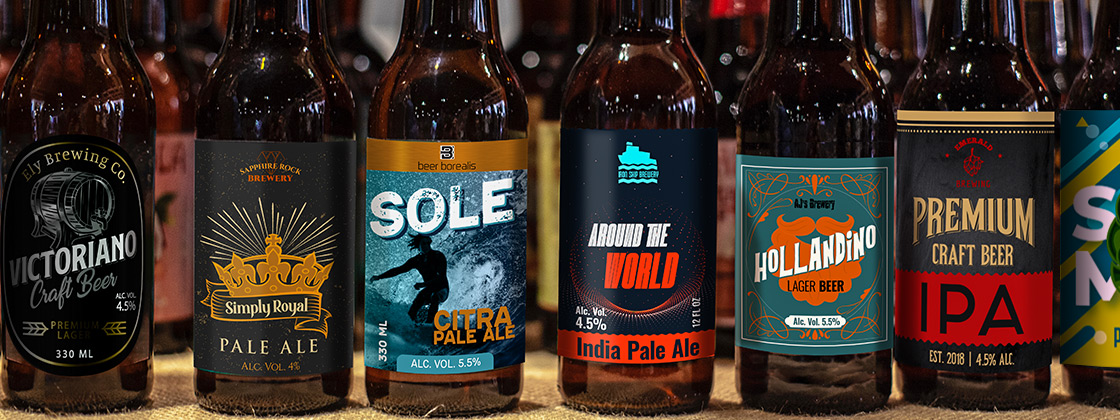Dating from at least the 5th millennium BC, beer is one of the oldest drinks humans have produced. Historical discoveries reveal that the ancient Egyptians and Mesopotamians brewed and enjoyed this refreshing beverage. Over the centuries beer production and beer consumption flourished, and today, people still love brewing and drinking beer. In fact, beer has become one of the most popular beverages in the world.
Thus, it’s no surprise that the brewing industry is blooming and has become a global business. This means there is limitless diversity of beer flavors on the market, and beer brewers are constantly working on inventing new tastes, textures, aromas, colors and more.
While the taste and the quality of the beer is undoubtedly crucial for the success of one’s beer business, there are also other elements that are very important for establishing a distinct brand identity on the market, and one of them is having unique and attractive beer labels.
When it comes to beer labels, besides creating an attractive design, beer brewers have a responsibility to create a beer label that complies with the government regulations and standards in their country.
In the United States, the Alcohol and Tobacco Tax and Trade Bureau (TTB) is responsible for administering and regulating the operations of breweries. And one of their specific functions is overseeing the beer labeling regulations. The TTB determines what information is mandatory for beer labels, how the beer bottle labels should look, where to place certain elements etc.
Beer Labeling Regulations
No matter how small or big a beer brewery business is, it is the sole responsibility of brewers to follow the Federal laws and regulations and prepare beer labels in accordance with them. In particular, they must follow the labeling and advertising requirements found at 27 CFR Part 7, Labeling and Advertising of Malt Beverages and 27 CFR Part 16, Alcoholic Beverage Health Warning Statement.
However, navigating these regulations and ensuring compliance can often be a challenging task, so we’ve prepared an outline of what information is mandatory to include on beer labels, with additional resources about beer labeling.
Mandatory beer label information
- Brand name (This is usually the most prominent element on the beer label and it must appear on the front of the container and be readily legible.)
- Class and type designation (This is the specific identity of the malt beverage. Examples are beer, ale, lager.)
- Name and address (The name and address of the producer/bottler or importer (if imported) must appear on the beer label.)
- Net content (Net contents must be expressed in American measure but may also be expressed in metric measure.)
- Alcohol content (The alcohol content statement expressed in percent by volume is optional unless it is required by State law.)
- FD&C Yellow #5 Disclosure (If the malt beverage contains FD&C Yellow #5 “CONTAINS FD&C YELLOW #5″ statement must appear on the label.)
- Saccharin Disclosure (If the malt beverage contains saccharin the following statement must be included on the label “USE OF THIS PRODUCT MAY BE HAZARDOUS TO YOUR HEALTH. THIS PRODUCT CONTAINS SACCHARIN WHICH HAS BEEN DETERMINED TO CAUSE CANCER IN LABORATORY ANIMALS.”)
- Declaration of sulfites (“CONTAINS SULFITES” or “CONTAINS (A) SULFITING AGENT(S)” must appear on the label of any malt beverage containing 10 or more parts per million (ppm) sulfur dioxide.)
- Declaration of aspartame (“PHENYLKETONURICS: CONTAINS PHENYLALANINE.” must appear on the label of any malt beverage containing aspartame.)
- Health warning statement
(By law the following statement is required on all alcoholic beverages containing 0.5% or more alcohol by volume:
GOVERNMENT WARNING: (1) According to the Surgeon General, women should not drink alcoholic beverages during pregnancy because of the risk of birth defects. (2) Consumption of alcoholic beverages impairs your ability to drive a car or operate machinery, and may cause health problems.) - Country of Origin (This statement is required under the U.S. Customs Service regulations for any imported malt beverage.)
For more specific beer labeling requirements on how to design labels for beer, start by consulting the following Beverage Alcohol Manual (BAM) by the Alcohol and Tobacco Tax and Trade Bureau (TTB).
Choosing and Printing Beer Labels
At Beverage Labels we specialize in creating high-quality beer labels that will ensure your product looks appealing and professional. Our durable and water-resistant custom beer labels will stay applied on the beer bottle even after rough handling – in any transportation, storage and temperature conditions.
We offer a wide variety of sizes, shapes and beer label materials such as paper, polyester film (PET), polypropylene, vinyl, shrink-sleeve, film etc. Moreover, you can choose to add top coating such as lamination or varnish to your custom beer bottle labels. Not only will you improve and further personalize your beer labels but it will also protect them from scratches, fading, moisture and other environmental influences. Depending on your preference you can request from glossy, semi-glossy, matte or clear, ultra-glossy lamination.
Whether you produce craft beer in small batches or you’re a national beer brewery, we can print custom beer labels for any of your needs. Our selection of printing techniques and solutions allow us to print beer labels in both small and large runs and in any size and shape.
If you want your beer labels professionally printed with attention to details, contact Beveragelabels.net print experts team and let us help you make the perfect choice.

